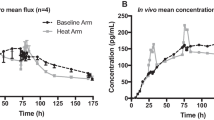Abstract
The performance of two prototypical ethanol-water flux-enhanced transdermal therapeutic systems were compared to the performance of commercial Transderm-Nitro 10. This was a single- center, open- label, three- treatment, randomized crossover study in six healthy subjects who completed the study. Concurrent with each transdermal treatment, an infusion of the stable isotope [15N]3-nitroglycerin was administered. The use of double isotope methodology was incorporated into this study to minimize the variation introduced by fixed-effect error on the evaluation of transdermal flux. The objectives of this study were to isolate experimentally and characterize the average flux enhancement of each prototype, to determine the temporal profile of delivery, and to evaluate the components of variance of drug delivery from each transdermal system. The results of this study showed that the two flux-enhanced transdermal systems with different fill volumes both produced flux enhancement factors of 2 to 3 relative to Transderm-Nitro 10. Prototype B demonstrated a 57% reduction in intersubject variation relative to Transderm-Nitro 10 indicative of enhanced control of drug permeation across a subject population. Prototype A, while reducing intersubject variations, was less than optimal. Both prototypes demonstrated comparable intrasubject variation relative to Transderm-Nitro 10, indicating similar stability for within-subject transdermal drug delivery. The flux enhancement and variational properties of Prototype B were consistent with those intended based on mechanistic considerations of mutual nitroglycerin and ethanol- coupled transdermal delivery.
Similar content being viewed by others
References
A. Gerardin, D. Gaudry, and D. Wantiez. Gas chromatograpic mass spectrometric determination of 1,2,3-propanetrioltrinitrate (nitroglycerin) in human plasma using the nitrogen-15 labelled compound as internal standard.Biomed. Mass Spectrom. 9:333–335 (1982).
D. Gaudry, A. Gerardin, C. Briand, and D. Wantiez. Quantitiative determination of nitroglycerol in human plasma by gas chromatography negative ion mass spectrometry using15N labelled nitroglycerol as internal standard.Biomed. Mass Spectrom. 11:276–277 (1984).
B. Berner. The pharmacokinetics of the removal and re-application of transdermal patches.J. Control Release 1:127–135 (1984).
G. M. Kochak, R. A. Smith, R. L. Choi, V. John, V. Tipnis, F. Honc, J. K. deSilva, and D. J. Weidler,. Intra- and intersubject variability: Mixed-effects statistical analysis of repeated doses of an angiotensin converting enzyme inhibitor, CGS 16617.Pharm. Res. 6:328–331 (1989).
H. Schaffe.The Analysis of Variance, Wiley, New York, 1959, pp. 221–235.
B. Berner, J. H. Otte, G. C. Mazzenga, R. J. Steffens, and C. D. Ebert. Ethanol: water mutually enhanced transdermal therapeutic system I: Nitroglycerin solution properties and membrane transport.J. Pharm. Sci. 78:314–318 (1989).
B. Berner, G. C. Mazzenga, J. H. Otte, R. J. Steffens, R. Juang, and C. D. Ebert. Ethanol: water mutually enhanced transdermal therapeutic systemII: Skin permeation of ethanol and nitroglycerin.J. Pharm. Sci. 78:402–407 (1989).
R. C. Wester, P. K. Noonan, S. Smeach, and L. Kosobud. Pharmacokinetics and bioavailability of intravenous and topical nitroglycerin in the rhesus monkey: Estimate of percutaneous first-pass metabolism.J. Pharm. Sci. 72:745–748 (1983).
E. Nakashima, P. K. Noonan, and L. Z. Benet. Transdermal bioavailability and first-pass skin metabolism: A preliminary evaluation with nitroglycerin.J. Pharmacokin. Biopharm. 15:423–437 (1987).
P. K. Noonan, R. L. Williams, and L. Z. Benet. Dose dependent pharmacokinetics of nitroglycerin after multiple intravenous infusions in healthy volunteers.J. Pharmacokin. Biopharm. 13:143–157 (1985).
F. W. Lee, T. Salmonson, C. H. Metzler, and L. Z. Benet. Pharmacokinetics and pharmacodynamics of glyceryl trinitrate and its two dinitrate metabolites in conscious dogs.J. Pharmacol. Exp. Ther. 255:1222–1229 (1990).
Author information
Authors and Affiliations
Rights and permissions
About this article
Cite this article
Kochak, G.M., Berner, B., Leal, M. et al. Variational analysis of the transdermal delivery rate from two prototypical ethanol-water nitroglycerin TTS devices and Transderm-Nitro 10 in the normal population. Journal of Pharmacokinetics and Biopharmaceutics 20, 443–459 (1992). https://doi.org/10.1007/BF01061465
Received:
Revised:
Published:
Issue Date:
DOI: https://doi.org/10.1007/BF01061465



